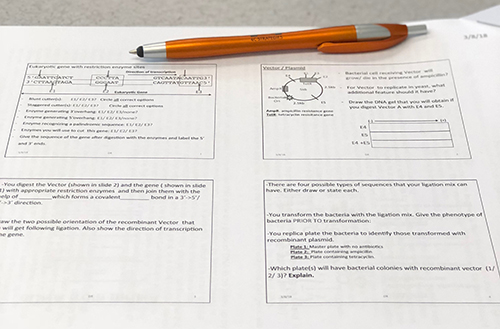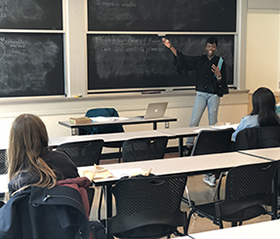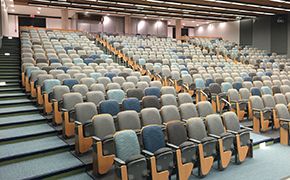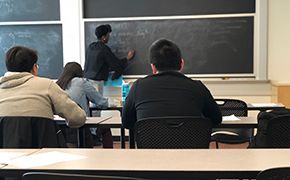Instructor Insights pages are part of the OCW Educator initiative, which seeks to enhance the value of OCW for educators.
Below, Dr. Diviya Ray responds to questions about how she teaches 7.013 Introductory Biology.
OCW: Tutors are available for any student who wants extra help with the course material. This service is offered free of charge. Who serves as tutors? How often do students take advantage of this opportunity?
Diviya Ray: Undergraduate students who have previously taken one of the five versions of Introductory Biology and have received a strong grade in the course and participated actively in the class and recitations, or who have passed the Biology Advanced Standing Exam (ASE), are given the opportunity to work as tutors.
A good number of students in the class (15-20%) take advantage of tutoring support on a one-time or regular basis. The number of students seeking help increases as the course progresses, especially after the first exam or when the problem sets are due. The tutors are especially helpful for students who have failed one or more exams.
The tutors have access to the class materials. Depending on the material that a student wants to go through during the tutoring session, the tutors can use the posted material to prepare for the tutoring session.
OCW: Scaffolded exercises are a unique aspect of this course. Tell us more about them.

A scaffolded exercise students encountered during a 7.013 Introductory Biology recitation session. (Image by MIT OpenCourseWare.)
Diviya Ray: During this iteration of the course, we experimented with using scaffolded exercises during recitations addressing fundamental course material. What this means is that we provided support to the students that helped them walk step-wise through a problem-solving process to ultimately apply the concepts they learned in the lectures to solve more complex problems. We were able to monitor the progress of the students in recitations, address their misconceptions, and provide real-time feedback based on their responses.
The development of a scaffolded exercise first requires defining the concept that the student needs to understand. You design a simple problem related to the concept. Then you lay down the steps (each step itself is a sub-concept) that the students follow to solve the problem. Then you make two to three versions of the same problem and see if students are able to solve them on their own. This allows you to understand if the concept is clear to them or helps you identify and address the parts with which the students are still having difficulty.
Students seemed to benefit from the scaffolded exercises we designed. However, the teaching assistants seemed hard-pressed for time as they tried to cover multiple concepts within the allotted 50-minute sessions. I think we will have to come up with strategies to tackle this issue so that the teaching assistants are able to efficiently embed scaffolded exercises into their recitations.
› Read More/Read Less
Teaching Assistant Insights
Below, Nneoma Okonkwo, a senior in the Biological Engineering department, responds to questions about her experiences using scaffolded exercises as a teaching assistant in 7.013 Introductory Biology.

Nneoma Okonkow facilitating a 7.013 Introductory Biology recitation session. (Image by MIT OpenCourseWare.)
OCW: How did you use scaffolded exercises during your recitation sessions?
Nneoma Okonkwo: Scaffolded exercises involve walking students step-by-step through the method of solving problems, followed by having them solve slightly more complex but similar problems, using the steps from the example. In recitations, the students were given handouts with the steps to solve given problems. I would walk through each step on the board, ensuring that each was crystal clear. Then, I would have them solve the new problem on their own and one or several students would walk me and their peers through the steps to the answer. The scaffolded exercises really helped solidify concepts and ways to go about thinking through problems, by virtue of their reiterative nature.
OCW: What advice for other teaching assistants do you have about using scaffolded exercises?
Nneoma Okonkwo: Take the time to walk the students through each step and have them walk you through the new problems instead of re-lecturing in recitations. This way, you can easily figure out what steps or areas they did not understand as well, or you can be certain that they have a good grasp of the method.
OCW: Would you encourage other instructors to use scaffolded exercises in their introductory biology courses?
Nneoma Okonkwo: Yes, I would definitely recommend using scaffolded exercises because introductory biology courses usually comprise a diverse body of students, with some students having a solid biology foundation, and some having little or none. The scaffolded exercises can help those in the latter category ease their way into the novel material and get up to speed with the former, while also serving as good refreshers for those who are more familiar with the material.
Student Insights
Below, Anjolaoluwa Feymi, a chemical engineering major, shares insights about being a student in 7.013 Introductory Biology.
Most helpful teaching strategies used by instructors
I found it helpful that the teaching team offered a variety of office hours and collaboration during those office hours. It was useful to solve problems during office hours and review materials needed for approaching problems during recitations.
On scaffolded exercises
I recommend that other instructors try scaffolded exercises because they offer a quick way to digest information and are easy ways to break points down into tiny bits that can be addressed logically.
Recitations are the most important part of the course.
— Anjolaoluwa Feymi
Advice for how to succeed in the course
Don't get flustered after an exam. There’s plenty of time and opportunity to bounce back. Recitations are the most important part of the course, followed closely by meaningful time spent solving problems on your own. Problem sets should not be taken lightly and are a great aid for your exams and overall understanding.
Curriculum Information
Prerequisites
There are no formal prerequisites for this course, but we do presuppose high school-level biology and chemistry (especially familiarity with the fundamental aspects of chemical structure).
Requirements Satisfied
GIR ![]()
Offered
Every spring semester
Student Information

Breakdown by Year
Mostly undergraduate students, with over 100 first-year students
Breakdown by Major
Variety of majors
Typical Student Background
This course is offered as a GIR ![]() , which means we get a diverse array of students. Some students have taken AP Biology and have had experience working in labs. Other students are taking the course to prepare for medical school. In the same classroom, we also have students who have not had biology since their freshman year in high school. Striking the right instructional balance to meet the needs of this diverse group of students is one of the biggest challenges faced by the 7.013 teaching team.
, which means we get a diverse array of students. Some students have taken AP Biology and have had experience working in labs. Other students are taking the course to prepare for medical school. In the same classroom, we also have students who have not had biology since their freshman year in high school. Striking the right instructional balance to meet the needs of this diverse group of students is one of the biggest challenges faced by the 7.013 teaching team.
During an average week, students were expected to spend 12 hours on the course, roughly divided as follows:
In Class
- Met 3 times per week for 1 hour per session; 38 sessions total.
- Class sessions were lecture-based.
Recitation
- Met 2 times per week for 1 hour per session; 27 sessions total. Regular attendance expected but not mandatory.
- Teaching assistants reviewed key lecture concepts, guided students through scaffolded exercises, and supported students in solving problems.
Out of Class
- Students completed problem sets, prepared for exams, and attended office hours and tutoring sessions as needed.
Semester Breakdown
| WEEK | M | T | W | Th | F |
|---|---|---|---|---|---|
| 1 |  |  |  |  |  |
| 2 |  |  |  |  |  |
| 3 |  |  |  |  |  |
| 4 |  |  |  |  |  |
| 5 |  |  |  |  |  |
| 6 |  |  |  |  |  |
| 7 |  |  |  |  |  |
| 8 |  |  |  |  |  |
| 9 |  |  |  |  |  |
| 10 |  |  |  |  |  |
| 11 |  |  |  |  |  |
| 12 |  |  |  |  |  |
| 13 |  |  |  |  |  |
| 14 |  |  |  |  |  |
| 15 |  |  |  |  |  |
| 16 |  |  |  |  |  |
 No classes throughout MIT
No classes throughout MIT Recitation
Recitation Exam
Exam Lecture session
Lecture session Office hour (optional)
Office hour (optional) Problem set due
Problem set dueCourse Team Roles
Professors (Prof. Hazel Sive & Prof. Angelika Amon)
Two professors delivered the lectures for the course. The recitations, problem sets, and exams were designed around their lecture materials. They worked closely with the course instructor and provided feedback during the development of the exams and problem sets. They offered office hours when they were on campus, and were available to the course instructor, teaching assistants, and students via email and by appointment throughout the course.
Instructor (Dr. Diviya Ray)
The instructor for the course had both administrative and academic responsibilities. As the course administrator, the instructor was the common point of contact for the students, professors, teaching assistants, and other departments on campus, such as Student Support Services. She created and maintained the class website, posted weekly announcements, maintained the class calendar, and responded to emails from students and the teaching staff. The instructor also hired the tutors and graders for the course and approved their weekly work hours. Additionally, she approved the grades for all problem sets and exams, while also arranging for accommodations for students with learning needs as identified by Student Disability Services.
The academic responsibilities of the instructor involved working closely wih the course professors and designing the recitation summaries, their associated questions and answer keys, and scaffolded exercises, which the teaching assistants use to teach recitations. She met with the teaching assistants weekly as a group and provided them with guidance and instructions for teaching the recitations successfully. The instructor also generated problem sets and exams, finalizing them based on suggestions and feedback from the professors and teaching assistants. She offered weekly office hours, provided pre-exam review sessions, and generated pre-exam study sheets. Monitoring the class forum and responding to students’ questions on the forum were also among her responsibilities. She attended all lectures and gave lectures if the professors were unavailable.
Teaching Assistants
Nine teaching assistants attended the lectures and facilitated recitation sessions. They also took the exams and completed the problem sets before these materials were given to students. Teaching assistants held office hours each week, proctored and graded exams, and assessed problem sets, under the supervision of the course instructor.
Graders
Graders were undergraduate students who helped the teaching assistants assess students’ work on problem sets. The teaching assistants and course instructor supervised their work.
Tutors
Tutors were undergraduate students who tutored 7.013 students needing extra help on a one-time or regular basis. They sat in on one-on-one tutoring sessions offered by the instructor, if tutoring for the first time. They communicated with instructor when administrative or academic questions arose. This service was provided to students free of cost.


 Room 1 of 2
Room 1 of 2 

 51%
51%  17%
17%